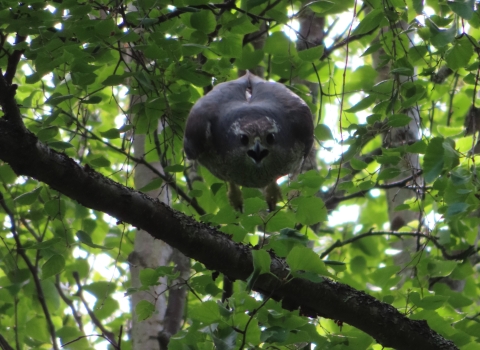Oil and gas exploration and extraction use and generate substantial volumes of water. The generated water, known as produced water, is the largest byproduct of the oil and gas industry. Produced water contains a mix of oil and other hydrocarbons, drilling muds and fluids, salts, heavy metals, surfactants, and other chemicals. Most produced water is saltier than seawater and ranges in salinity from ≤ 1% to greater than 50%. For reference the salinity of seawater is 3.5%.
To separate the crude oil from produced water and other drilling fluids, different earthen pits are constructed including reserve pits, skim pits, and flare pits. Once the drilling fluids have been separated, they are typically disposed of in evaporation ponds. These open-top pits, tanks, and containers pose a threat to migratory birds.
How do oil and gas pits impact migratory birds?
Take of migratory birds can occur through entrapment in pits and equipment. Trail (2006) estimated that oil pits kill about 840,000 birds every year. Migratory birds may mistake oiled and produced waters for water sources and become entrapped. They may also be attracted to already entrapped prey and become entrapped themselves. Birds can die from entrapment, loss of insulation from oiling, or by being poisoned by ingesting oil and other contaminants. Entrapped birds may not be able to get out of a pit due to sticky oil fluids, impaired feathers, or steep, synthetically lined pit walls. Birds that land on or fall into a pit become covered with oil and may ultimately die from drowning, starvation, cold or heat stress, or effects of ingested oil.
Why does this happen?
From the air, birds may have trouble distinguishing wetlands and other bodies of water from small pits, ponds, and reservoirs containing oil. They may be attracted to pits and open tanks used to store and separate oil from produced water due to the presence of insects. Birds may approach oil-covered pits and ponds to drink and fall into the pits or become entrapped if the banks of the pits are oiled.
What can I do?
Solutions to preventing bird mortality in oil pits and evaporation ponds are fairly simple and straightforward and are being implemented by many oil operators. Closed-loop systems reduce the amount of drilling waste produced, require little to no maintenance, and can be moved from site to site, potentially reducing operator costs. These systems are the most effective measure to prevent bird exposure to oil and other hazardous chemicals and can eliminate soil contamination and remediation expense.
If a closed-loop system or closed tanks are not feasible, all open containers should be covered in a manner that does not entangle or entrap birds and is constructed and maintained to remain intact above the surface of the container. The most common practice used for bird exclusion is the installation of bird safe netting above the surface of liquid. This method is effective for pits up to approximately 1 acre in size. However, attempting to install and maintain netting over an area greater than 1 acre may be prohibitively expensive and require routine maintenance to avoid sag and manage any birds that are actively caught in the netting structure structure
Something temporarily or permanently constructed, built, or placed; and constructed of natural or manufactured parts including, but not limited to, a building, shed, cabin, porch, bridge, walkway, stair steps, sign, landing, platform, dock, rack, fence, telecommunication device, antennae, fish cleaning table, satellite dish/mount, or well head.
Learn more about structure . Pits greater than 1 acre my require additional methods, such as active hazing, to prevent birds from becoming entrapped.
Any oil or waste fluid spill or leak should be cleaned up immediately.
Library Documents
- USFWS Mountain-Prairie Region Environmental Containments website
- Migratory Bird Mortality in Oilfield Wastewater Disposal Facilities
- USFWS Best Practices for Migratory Bird Care During Oil Spill Response



